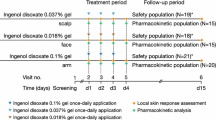Abstract
The safety and efficacy of imiquimod 5% cream is being evaluated for the treatment of dysplastic lesions of the epidermis (actinic keratoses, AK). The objective of this clinical study was to describe the pharmacokinetics and safety of topical imiquimod during multiple dosing of AK subjects. A total of 58 adult subjects with 5 to 20 AK lesions at the treatment site applied imiquimod cream three times per week for up to 16 weeks as follows: 12 males and 11 females applied 12.5 mg imiquimod to the face; 11 males applied 25 mg to the entire balding area of the scalp; and 12 males and 12 females applied 75 mg to both hands and forearms. Pharmacokinetics and safety were assessed after the first and last doses, as well as biweekly. Imiquimod and its metabolites were measured in the serum and urine using sensitive liquid chromatography/mass spectrometry methods. Less than 0.6% of the applied doses was recovered in the urine of all subjects. Serum imiquimod levels were low, reflecting minimal dermal absorption, and increased with dose, although not proportionally. Peak levels at the end of dosing were 0.1, 0.2, and 1.6 ng/ml for the face, scalp, and hands/arms groups, respectively. A two- to fourfold accumulation was seen at the end of dosing. Local application site reactions were the most common adverse event, reported by approximately 50% of the subjects in each treatment group. The small number of systemic adverse events, including ‘flu-like symptoms, were mostly mild and did not show a dose response. Thus, minimal systemic absorption and good safety margins for topical imiquimod were seen in AK subjects with doses as high as 75 mg three times per week for 16 weeks.


Similar content being viewed by others
Abbreviations
- AK:
-
Actinic keratosis
- 2,5-AS:
-
2′5′-Oligoadenylate synthetase
- AUC:
-
Area under the concentration-time curve
- Cmax:
-
Maximum serum concentration
- IFN:
-
Interferon-alpha
- IL-1RA:
-
Interleukin-1 receptor antagonist
- Rmax:
-
Maximum change from baseline value
References
Frost CA, Green AC (1994) Epidemiology of solar keratoses. Br J Dermatol 131:455–464
Callen JP, Bickers DR, Moy RL (1997) Actinic keratoses. J Am Acad Dermatol 36:650–653
Gupta AK, Browne M, Bluhm R (2002) Imiquimod: a review. J Cutan Med Surg 6:554–560
Miller RL, Gerster JF, Owens ML, Slade HB, Tomai MA (1999) Imiquimod applied topically: a novel immune response modifier and new class of drug. Int J Immunol 21:1–14
Bogdan C (2000) The function of type I interferons in antimicrobial immunity. Curr Opin Immunol 12:419–424
Schon M, Bong AB, Drewniok C, Herz J, Geilen CC, Reifenberger B, Slade HR, Gollnick H, Schon MP (2003) Tumor-selective induction of apoptosis and the small-molecule immune response modifier imiquimod. J Natl Cancer Inst 95:1138–1149
Stockfleth E, Meyer T, Benninghoff B, Salasche S, Papadopoulos L, Ulrich C, Christophers E (2002) A randomized double-blind, vehicle-controlled study to assess 5% imiquimod cream for the treatment of multiple actinic keratoses. Arch Dermatol 138:1498–1502
Salasche SJ, Levine N, Morrison L (2002) Cycle therapy of actinic keratoses of the face and scalp with 5% topical imiquimod cream: an open-label trial. J Am Acad Dermatol 47:571–577
Lebwohl M, Dinehart S, Whiting D, Lee PK, Tawfik N, Jorizzo J, Lee JH, Fox TL (2004) Imiquimod 5% cream for the treatment of actinic keratosis: results from two phase III, randomized, double-blind, parallel group, vehicle-controlled trials. J Am Acad Dermatol (in press)
Stockfleth E, Trefzer U, Garcia-Bartels C, Wegner T, Schmook T, Sterry W (2003) The use of Toll-like receptor-7 agonist in the treatment of basal cell carcinoma: an overview. Br J Dermatol 149 [Suppl 66]:53–56
Sauder DN, Skinner RB, Fox TL, Owens ML (2003) Topical imiquimod 5% cream as an effective treatment for external genital and perianal warts in different patient populations. Sex Transm Dis 30:124–128
Gollnick H, Barasso R, Jappe U, Ward K, Eul A, Carey-Yard M, Milde K (2001) Safety and efficacy of imiquimod 5% cream in treatment of penile genital warts in uncircumcised men when applied three times weekly or once per day. Int J STD AIDS 12:22–28
O’Mahony C, Law C, Gollnick HP, Marini M (2001) New patient-applied therapy for anogenital warts is related favorably to patients. Int J STD AIDS 12:565–570
Owens ML, Bridson WE, Smith SL, Myers JA, Fox TL, Wells TM (1998) Percutaneous penetration of Aldara cream, 5%, during the topical treatment of genital and perianal warts. Prim Care Update Ob Gyns 5:151
McQuinn RL, Machacek JH, Draper AM, Myhre PE, Carlson GL, Wells DA (1994) Use of Empore extraction disks for preparative purification and concentration of imiquimod and metabolites from large volumes of urine. Pharm Res [Suppl] 11:S24
Soria I, Myhre P, Horton V, Ellefson P, McCarville S, Schmitt K, Owens M (2000) Effect of food on the pharmacokinetics and bioavailability of oral imiquimod relative to a subcutaneous dose. Int J Clin Pharmacol Ther 38:476–481
Fried MW (2002) Side effects of therapy of hepatitis C and their management. Hepatol 36 [Suppl 1]:S237–244
Hemmi H, Kaisho T, Takeuchi O, Sato S, Sanjo H, Hoshino K, Horiuchi T, Tomizawa H, Takeda K, Akira S (2002) Small anti-viral compounds activate immune cells via the TLR7 MyD88-dependent signaling pathway. Nat Immunol 3:196–200
Acknowledgements
The authors would like to acknowledge the following individuals who contributed to this study report: Sharon Parrish, Nanda Gosala, Jim Lee, Bruce Ekholm, Adele Hoglin, Paula Myhre, Sagar Kawle, Anthony Pierce, Kirsten Watne and Debra Kielhold from 3 M Pharmaceuticals; Simone Jones from SFBC Fort Myers; and Tammy Johnson from Orlando Clinical Research Center. This study (1402-IMIQ) was sponsored by 3 M Pharmaceuticals.
Author information
Authors and Affiliations
Corresponding author
Rights and permissions
About this article
Cite this article
Harrison, L.I., Skinner, S.L., Marbury, T.C. et al. Pharmacokinetics and safety of imiquimod 5% cream in the treatment of actinic keratoses of the face, scalp, or hands and arms. Arch Dermatol Res 296, 6–11 (2004). https://doi.org/10.1007/s00403-004-0465-4
Received:
Revised:
Accepted:
Published:
Issue Date:
DOI: https://doi.org/10.1007/s00403-004-0465-4




